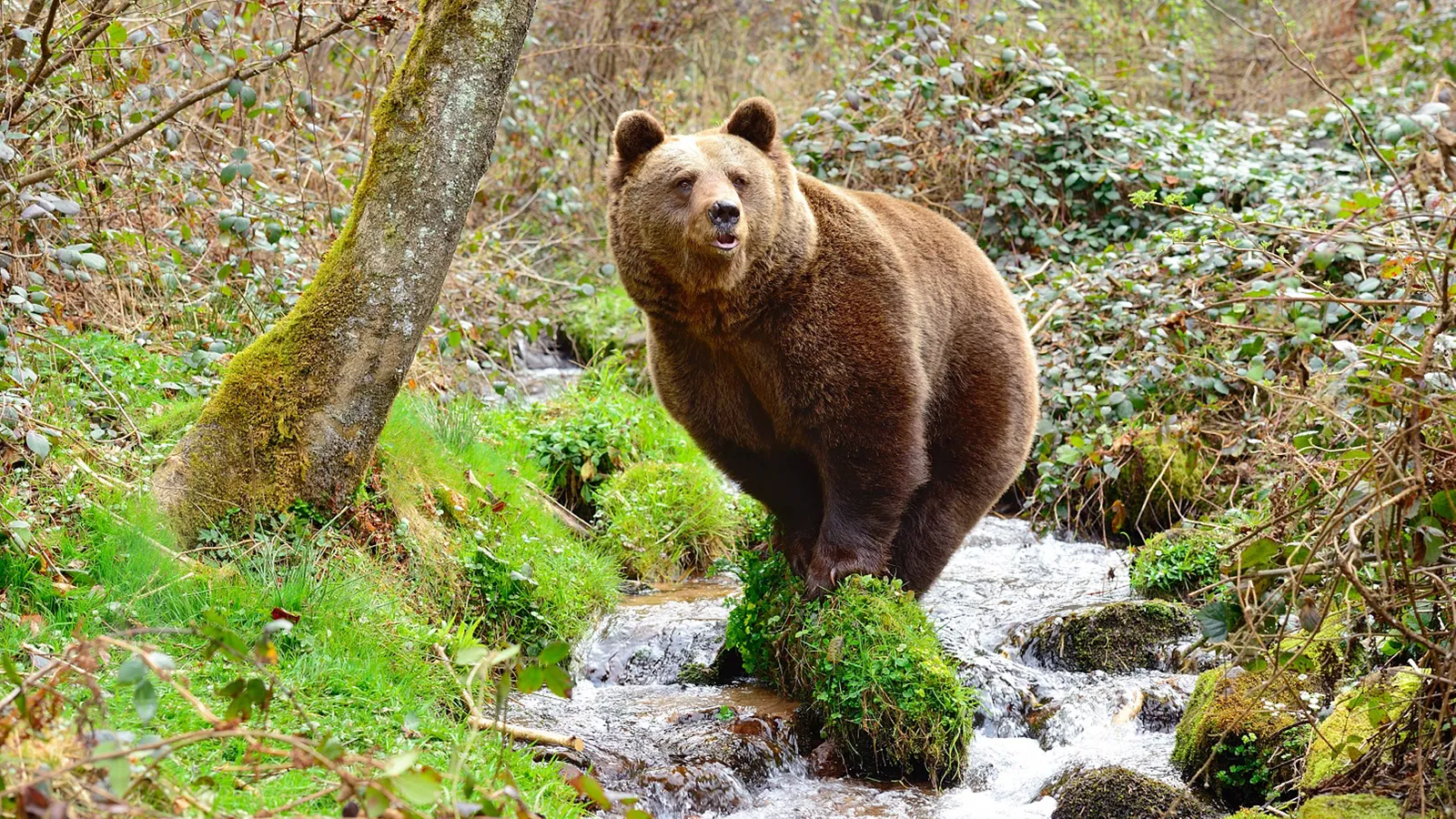The Alpine row over 'problem bears'
A debate over troublesome bears in the Alps shows the complex challenge of rewilding large carnivores.

It was May 2001, and the team behind a pioneering brown bear rewilding project in the Italian Alps were jubilant. "Today, Jurka arrived!" they announced proudly. "A splendid 90kg (198lbs) specimen joins the family of bears imported from Slovenia." Jurka peeked out of her transport container, then climbed down a ramp into her forested new home, the Adamello Brenta Nature Park in Trentino.
In much of the Alps, bears had been hunted into extinction and only remained as stuffed specimens in museums. Now an European Union-funded project called Life Ursus was slowly turning back the clock. The population grew to around 100 today, beyond even the rosiest projections.
But after a series of attacks on people, the future of the bears is now in doubt. What's going on? Is a tiny number of isolated incidents sparking an Alpine mass panic? Or is there a genuine pattern of unusually troublesome behaviour among the returning bears?
The carnivores' comeback
In the early days, a majority of locals supported the Life Ursus project. Wildlife groups and scientists praised it as a conservation success, and a potential model for brown bear recovery. Most of the bears lived shyly in the forest, fed on insects, plants and berries, and avoided humans. A few crossed the Alps, popping up in Austria, Germany and Switzerland. Eventually, conservationists hoped, such dispersal might help create a kind of Alpine bear belt – a border-crossing habitat that would ensure the species' long-term survival.
Today, the picture looks less happy. Jurka now lives behind a heavily fortified fence in a wildlife park in Germany, having been removed from Trentino for being a potential threat to humans. This year, Jurka's daughter JJ4, who was guarding her cubs, killed a jogger named Andrea Papi. It was JJ4's second attack, and one of seven bear attacks on humans in Trentino in the last decade. Other bears have mauled livestock and plundered beehives. In many parts of the Alps, there is a heated debate over what the return of the bears means for rural communities. Some people see their own freedom and safety under threat.
"The case in Trentino really scared people here," says Michaela Skuban, a wildlife biologist researching bear-human co-existence in Tyrol, on the Austrian side of the Alps. "They think: 'What if something like this happened here?'"
Skuban spent 16 years researching bears in Slovakia, which has around 1,700 bears, part of a population of 7,630 across the whole of the Carpathian mountains. In contrast, Tyrol only has one or two bears, who have wandered over from Trentino. Even that nascent population has been enough to spark concerns, she says. "People come up to me and ask, can I still go jogging? Can I let my child out into the garden? You might think it's laughable, but there's real uncertainty and fear."
Understanding why bears might come into conflict with people, several experts say, begins with understanding bears.
At first glance, research on bear behaviour is reassuring from a human point of view: we are not part of their diet, and they don't tend to prey on us. Giulia Bombieri, a specialist in human-wildlife conflict at MUSE, the Science Museum of Trento in Italy, has analysed some 600 brown bear attacks around the world together with colleagues. Their findings suggest that when bears attack, it is usually in defense against a perceived threat.
A wider 2023 analysis of attacks by all large carnivores showed a similar pattern of largely defensive attacks by bear species (including American black bears, Asiatic black bears, brown bears, sloth bears and polar bears). Also, bear attacks are only deadly in 9% of cases. In contrast, when felids such as lions and leopards attack humans, 65% of cases prove fatal.
However, that doesn't mean there's no reason to worry, according to Bombieri. Not every bear is shy, for a start. And even a shy bear may attack "if it ends up in the wrong situation", she says – a female with cubs may for example lash out when startled.
"Each bear has an extremely individual character and its own life story," says Claudio Groff. He is coordinator of the Large Carnivores Division of the Autonomous Province of Trento, which monitors the bears from the rewilding project. "Having said that, in Europe, a few animals, maybe 3-5% of the bear population, are what's known as 'problematic'. It can mean they are bold, they go into villages, and get close to people, which can be dangerous. Or, like JJ4, they may be very protective of their cubs. These aren't necessarily abnormal behaviours, but they're behaviours that are not acceptable to humans," he says.
In European media headlines and risk reports, there is a special name for such troublemakers: "problem bears" – "orsi problematici" in Italian, "Problembären" in German. It has become a catch-all term for bears who have caused alarm for very different reasons: bold ones, and ordinary ones reacting in defence. Differentiating between these types of "problem bear" is however crucial when it comes to preventing attacks, experts say.
Jurka, for example, falls into the bold-bear category. With hindsight, her relaxed arrival might have been a subtle sign of this, says Groff. He was part of the team welcoming her into her new habitat, and monitored her and others for years.
"When we brought over the 10 bears from Slovenia, there may have been one or two who already had that kind of problematic behaviour. Jurka was possibly already like that. When we saw her come down from the lorry, she didn't disappear into forest immediately like others. She lingered, took her time, even though there were people," he recalls. "Maybe – and this is just a hypothesis – it could have been a sign that this was an animal who did not fear humans," says Groff.
In Trentino, Jurka repeatedly ventured into villages to raid chicken coops and beehives, becoming bolder over time. She and her cubs caused around 50% of all bear-related damage in the area. Groff recalls her resisting attempts to scare her away, even with dogs. Such bold behaviour is known as being "food conditioned". It means a bear has learned that humans are an easy source of food: an situation that can be dangerous for both people and bears.
There is a common saying among bear experts, cited by several people interviewed for this article: "A fed bear is a dead bear". That's because a food-conditioned bear is likely to ultimately be put down.
In its early stages, food conditioning may seem harmless. A bear may persistently enter towns or villages to rummage through rubbish bins, or linger around tourist attractions. If such a bear is put down or captured, it can provoke public outrage, since the animal may not seem threatening at that point. However, if a bear loses its fear of humans, its behaviour can escalate to breaking into cars or attacking people to defend its food stash.
Bears at the bus stop
Skuban calls such bears Dorfbären: "village bears". She remembers them well from her time in Slovakia. "I wouldn't trust a village bear, because I would think, what's going on with this one, why isn't he running away? Is he about to defend his rubbish bin against me?" she says. "They're the kind of bears that hang around a bus stop at eight o'clock in the morning. Even if it's only a few, they can colour people's perception of the whole population. Because we are more likely to notice one bear at a bus stop, or in a public park, than to think of the fact that there are 10/15 who are out of sight in the forest, and who don't bother anyone."
Part of Skuban's project, which is funded by the non-profit Stiftung für Bären (Foundation for Bears), is to share some of the insights from Slovakia with locals in Tyrol, for whom the idea of living with bears is new. It is natural for humans to be worried about carnivores, she says: "Hearing about predators triggers a really ancient fear in us."
For Jurka, food-conditioning eventually put an end to her days in the wild. She was captured in 2007. There was no suitable shelter to house her at the time, so she was temporarily housed in a bear pit in a medieval Italian monastery called San Romedio, named after a saint who reportedly rode on a tamed bear. From there, Jurka was transferred to another bear sanctuary, and then, in 2010, to the Alternative Wolf and Bear Park in Germany's Black Forest. Three years ago, another food-conditioned bear from the project, DJ3, also known as Isa, joined her there.
"Captivity is a disaster for wild animals," says Bernd Nonnenmacher, the director of the park, which is run by the Foundation for Bears. "We see that very clearly with Isa and Jurka. Sure, they have a golden cage here, but it's still a confinement. Before, they had the mountains, the lakes, they could go wherever they liked."
Jurka's enclosure has been made as bear-friendly as possible, with trees and a stream, says Nonnenmacher. Nevertheless, she has tried to escape countless times. Now a fully grown bear of 41 stone (260kg), she once collected branches in her enclosure, then seemingly tried to use them to press down the electric fence surrounding it, allowing her to escape, according to Nonnenmacher. It's a trick she learned in her Trentino days, he says, when she used branches to press down electric fences around beehives. "Her yearning for freedom is unbroken, and that will never change."
Not only was Jurka's boldness her downfall, but she may have passed on some fatal habits to her cubs, unwittingly creating a clan of problem bears.
Jurka's firstborn was Bruno, also known as JJ1 based on his parents' initials (Jurka and a Slovenian bear called Joze). He was judged highly dangerous for his lack of fear of humans, was eventually shot after wandering into Germany, and is now a stuffed exhibit in a museum in Munich. Jurka's third offspring, JJ3, was shot in Switzerland after persistently rummaging for food in bins close to towns. The fifth, JJ5, died after being captured and sedated, after raiding chicken coops and bins close to people's homes.
"It's a tragic story," says Nonnenmacher. "Bears are very intelligent animals, with very individual personalities and different preferences, but they do teach their skills to their offspring. And that happened with Jurka and her descendants. They learned from Mum that where there are humans, there's food."
However, Groff points out that even within families bears can be very different. For example, JJ4 was not food-conditioned. "JJ4 never ventured into villages, even though she grew up with a mother who went into villages." Cubs don't necessarily turn out like their mothers, he says: "It's not that automatic."
As individual as these bear-human conflicts are, research suggests that a few simple steps can help prevent them. First, blocking access to food can stop bears from developing bad habits. And second, when it comes to ordinary bears, there are things we can do to avoid startling them.
"Bears are by their nature large predators, but they don't particularly prey on humans. It's usually because we surprise them that we set off these attacks," says wildlife scientist Tom Smith at Brigham Young University in Provo, Utah, who has spent 31 years conducting field work among bears. "Many of us who've studied them for a long time know that, with proper training and education, we can greatly minimise the amount of human-bear conflict. It's not like walking around with tigers or another large cat that actually sees you as food."
An analysis of almost 700 human-bear conflicts in Alaska by Smith and his colleagues found that the likelihood of an attack was reduced by being in a group. In areas with poor visibility, making noise by talking or clapping hands also helped. When bears hear humans approaching, they usually get out of the way, Smith says. (Read BBC Future's article on how to stay safe in bear areas).
In fact, the seven bear attacks on people in Trentino, which all occurred within the past decade, broadly fit those known conflict patterns. Most of them involved surprise encounters between bears, often with cubs, and hikers, joggers or mushroom-pickers. One involved a food-conditioned bear who had previously followed people.
Smith, who visited Trentino this year to meet local bear researchers, recommends carrying anti-bear pepper spray to deter bears who do get too close. "Going out there all on your own with no way to tell a bear 'no' is very bad. I wouldn't do that."
His research has shown the spray to be successful in 98% of close encounters. But the spray is illegal in much of Europe, for fear it might be used on people by criminals.
"If you're going into 'bear country' completely defenceless, people have a right to feel uncomfortable about that," Smith says. "I sympathise with the sense of vulnerability."
Skuban is similarly sympathetic, and highlights the plight of farmers in particular. They have been among the most vocal critics of the return of the bears – which has coincided with the comeback of another large carnivore, the wolf.
In several Alpine countries farmers have taken to the street to protest against predators, and some have taken sheep off summer pastures after finding mauled livestock.
"This is a new situation, and people are having to learn to live with bears again," Skuban says, adding that it's crucial to ask farmers what kind of practical support they need to feel safe. She has worked as a shepherd and has researched different methods of herd protection, such as keeping sheep dogs. But not all solutions work for all environments, she says. In Alpine regions where tourism is an important source of income, farmers worry that the highly protective dogs could also attack hikers. Still, she is hopeful that a solution can be found:
"If we're patient, and keep talking to each other, I think we can get there. It might mean a better system for farmers, and maybe, better scientific monitoring. It's a process, and it may take time," says Skuban.
Furthermore, while it's important to remove problematic bears, "that doesn't mean removing bears just because they're there", she says.
In Trentino, that issue of how to deal with problematic bears as a very last resort – putting them down, or capturing them – has turned out to be especially tricky.
"We've had huge difficulties when it comes to applying the rules for managing problematic bears," says Groff.
In principle, there is clear official guidance for this in Europe, supported by bear specialists around the world: after careful assessment, a bear deemed dangerous to humans has to be captured or put down. This was what Groff's department decided after JJ4's first attack on humans, in 2020. "We gave an order to put down this bear." However, animal rights activists challenged this, and a court eventually overturned the order. Further attempts to be allowed to remove her also failed.
"Then this bear attacked again," says Groff. "Very understandably, this really upset people who saw that a bear who had injured two people was left to move around freely until she killed a third one." Worst of all, the decision resulted in a person’s death. "A young man died because we couldn't put down that bear."
Groff emphasises that "no one wants to put down a bear, certainly not those of us who try to save them".
"But sometimes you have to sacrifice a problematic animal for the benefit of all the other bears who live quietly," he says. And ultimately, human life is more important than bear conservation, he adds.
In Groff's view, living with bears requires compromise on both sides: people have to take precautions, and bears "can't do whatever they like".
"There are some who say that the bears should be left in the forest and the solution is for humans to stay out of the forest," says Groff. "But that doesn't make any sense, because people go into the forest to hunt, find firewood, pick mushrooms, run, bike, and it's always going to be that way. The forest also belongs to the bear, but it doesn't only belong to the bear."
-bbc






